

Articles - Year 2001 - Volume 16 -
Systematization in Oncologic Mammaplasty
Sistematização em Mamoplastia Oncológica
ABSTRACT
The objective of this study was to emphasize the advantages of mastologists and plastic surgeons working together in a single surgical procedure to treat breast tumors. The authors describe their experience with 58 patients who underwent surgery in the Plastic Surgery Facilities at Hospital Divina Providência and Hospital Moinhos de Vento, both in the city of Porto Alegre, in the state of Rio Grande do Sul, Brazil, between 1998 and 2001. This surgery involved the removal of the tumor and breast reconstruction in a single surgical procedure. Patients were followed up clinically for at least 60 days. Follow-up included evaluation of clinical results, level of satisfaction with the physical aspect, and return to everyday activities. Breast reconstruction techniques have been described, according to the type of resection conducted by the mastologist. Authors have concluded that the combination of surgical oncologic treatment and reconstruction in a single intervention is a key factorfor quick recovery and for providing breast cancer patients with a good quality of life.
Keywords: Breast tumors; mastectomy; breast reconstruction
RESUMO
Este trabalho tem o objetivo de ressaltar as vantagens da atuação conjunta do mastologista e do cirurgião plástico, em ato operatório único, para tratamento dos tumores de mama. Os autores apresentam a experiência com 58 pacientes operadas no Serviço de Cirurgia Plástica do Hospital Divina Providência e no Hospital Moinhos de Vento, em Porto Alegre, durante o período de 1998 a 2001, com retirada do tumor e reconstrução da mama no mesmo procedimento cirúrgico. As pacientes foram acompanhadas clinicamente por 60 dias, no mínimo, e foram avaliados os resultados clínicos, o grau de satisfação com o aspecto físico e o retorno às atividades habituais. São descritas as técnicas de reconstrução da mama selecionadas segundo o tipo de ressecção efetuada pelo mastologista. Os autores concluem que o tratamento cirúrgico oncológico e a reconstrução realizados em intervenção única é um fator importante para uma recuperação rápida, com boa qualidade de vida das pacientes com câncer de mama.
Palavras-chave: Tumores de mama; mastectomia; reconstrução de mama
Annually, more than 170,000 women in the United States(1) are diagnosed with breast cancer. Breast can cer is the leading cause of death among women who die from malignant tumors both in the state of Rio Grande do Sul and in the city of Porto Alegre. In 1999, breast cancer was the fourth leading cause of death among women who die in the city of Porro Alegre (Table I, data from Rio Grande do Sul State Health Department). In the last three years (from 1998 to 2001), 572 cases of malignant breast tumors were diagnosed in a single pathology facility, in the city of Passo Fundo (Rio Grande do Sul) which covers an area with 2 million inhabitants(2).

Current therapeutic management provides a 5-year survival rate of 80% for patients diagnosed with invasive breast cancer(3). Considering the aesthetic relevance of the breasts, the mutilating effect of the disease, and the role women play in modern society, we have tried to develop a combined surgical technique to simultaneously remove the tumor and reconstruct the breasts. This technique should provide safe oncologic treatment, restore patients' self-esteem, enable them to go back to their everyday activities as quickly as possible, and allow them to wear their usual clothes with dignity(4).
The mastologist suggests the joint procedure to be conducted by the mastologist and the plastic surgeon to patients, explaining the therapeutic efficacy of the procedure, the cosmetic advantages and the lower cost provided by combining both procedures in a single surgical procedure. Emphasis is also placed on the reduction of psychological distress provided by a single surgical intervention and the ensuing results. These aspects have been widely accepted by patients, who, in some cases, have sometimes even seen this as an opportunity to correct their breasts with the plastic surgery (4,5,6).
MATERIALS AND METHODS
From 1998 to 2001, 58 patients with breast carcinoma underwent oncologic mammaplasty, performed by teams of mastologists and plastic surgeons in a single surgical procedure(7) at the Plastic Surgery Facilities of Divina Providência Hospital and Moinhos de Vento Hospital, in Porto Alegre. Patients were followed up for at least 60 days, after which a clinical evaluation was performed. A questionnaire was also administered to assess emotional aspects, self-esteem, psychological distress and psychosocial skills. Patients ranged in age from 26 to 62 years with an average age of 45.
The patients underwent bilateral intervention so as to ensure breast symmetry, and the best aesthetic results(9). While mastologists resected the tumor in one breast, plastic surgeons concomitantly reduced the volume of the contralateral breast. The tissue removed from the healthy breast was then sent for pathology analysis (Fig. 1a).
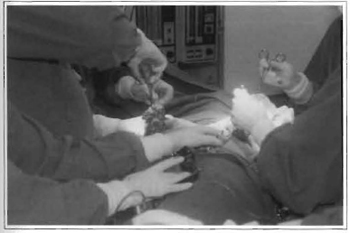
Fig. 1a -Two teams working together in a single surgical procedure.
With patients in a supine position, without dorsal elevation, access was a periareolar elliptical incision(7) and another infra-areolar ellipse, the base of which was an isosceles triangle (Fig. 1b). This technique has been used for 10 years in the facility and has been systematized by one of the authors(1). The affected breast was reconstructed with the remaining mammarian tissues, after results from pathology. Breasts were reconstructed with mononylon 2.0.
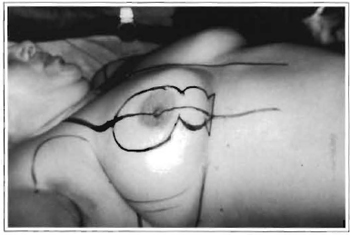
Fig. 1b -Design on patient skin, normally used as access and reconstruction route.
Local flaps or lower pedicles were used(8,10) (Fig. 1c). The latter were either attached to the skin saved by the mastologist to build the upper quadrant, or to the aponeurosis of the pectoralis major in order to obtain greater protection or to fill in resected areas. The skin was sutured with monocryl 4.0 or 5.0. One patient had a periareolar scar, while others had a periareolar scar with vertical and horizontal extensions ranging from 1 to 3 cm (Fig. 1d). When there was need for axillary drainage, a suction tube was placed for 5 days or until the amount of drained liquid no longer exceeded 20 ml in two hours.
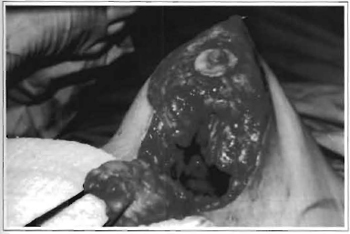
Fig. 1c -Displacement of the glandular base for the mastologist to resect the tumor.
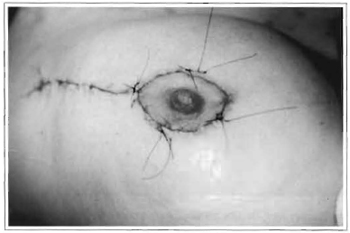
Fig. 1d -Final surgical scar.
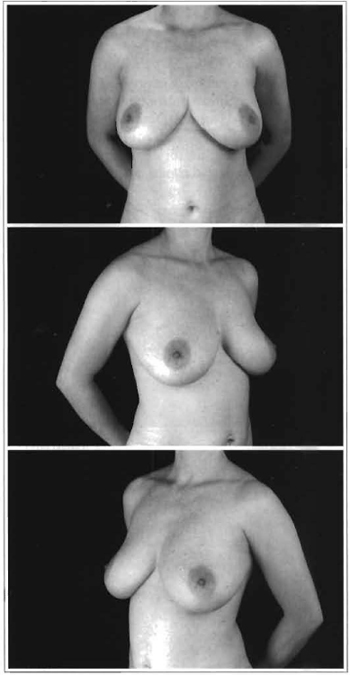
Figs. 2a -2c -Preoperative assessment: 26 year-old with 1 cm in situ carcinoma on right breast.
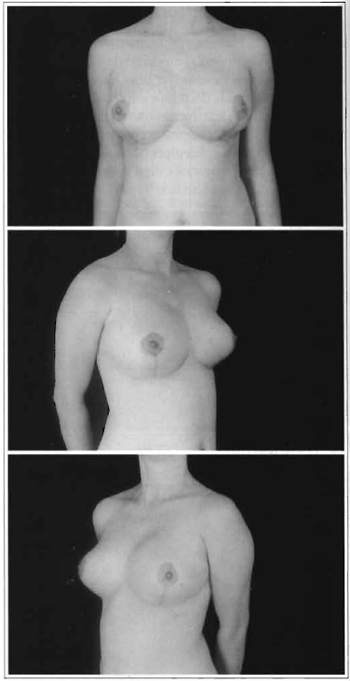
Figs. 2d -2f -Patient in picrure 2: at 6-month postoperative period. Resected tissue between reduction and sectorectomy: 300 g R breast, and 300 g L breast (resection of less than 1/5 of breast volume -Group I).
The 58 patients were classified into 4 groups according to the amount of tissue resected from the affected breast, type of histological lesion and the technique used (Table I). Group I included 7 patients with atypical lobular hyperplasia or clustered microcalcifications, who underwent minimal resection and reconstruction with local flaps. Group II (Figs. 3a-3c) included 16 patients with intraductal carcinoma, invasive ductal carcinoma, in situ medullary carcinoma or invasive medullary carcinoma(11). In this group, resections were smaller than 1/5 or the breast volume and reconstructions were done with local flaps or lower pedicles (Fig. 3d-3f). Group III (Figs. 4a-4c) included 50% of the cases studied and results of pathology were the same as in Group II. For these patients, resections were larger than 1/5 of the breast volume and reconstructions were made with local flaps, lower pedicles, and prostheses (Figs. 4d-4f). Six (6) patients were grouped as special cases in Group IV (Figs. 5a-5c). These patients bad their histologlcal diagnoses confirmed only during the intra-operative period. When it was found to be necessary to extend the resection, the decision to do so was made at the time of reconstruction, using flaps that are not normally used (Figs. 5d-5f).
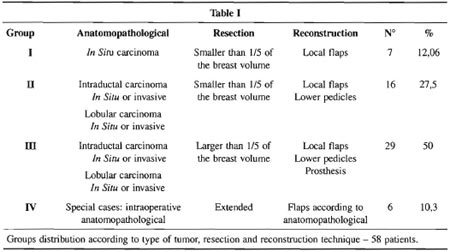

Figs. 3a -3c -Preoperative assessment: 41-year old, with 2.10 cm in situ carcinoma on L breast.
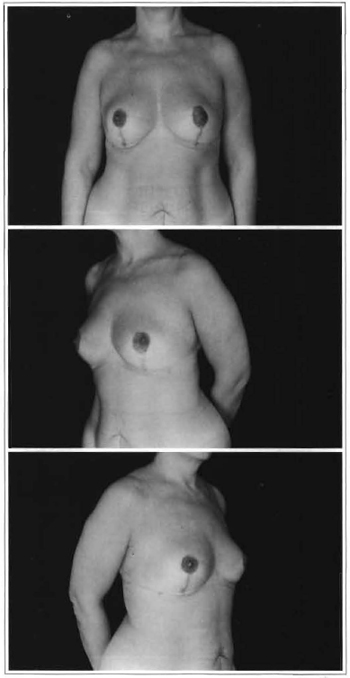
Figs. 3d -3f -Patient in picrure 3: at 1-month postoperative period. Tissue resected with sectorectomy: 160 g L breast and 180 g R breast (resection smaller than 1/5 of breast volume Group II).
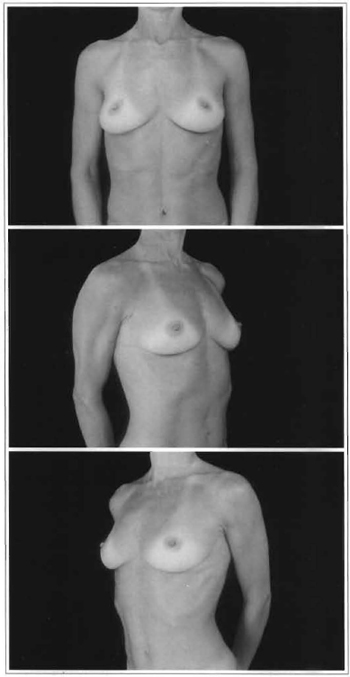
Figs. 4a -4c -Preoperative assessment: 40-year old, with invasive ductal carcinoma on breast and resection of 2/3 of the left gland and 2 cm fibroadenoma on R breast.
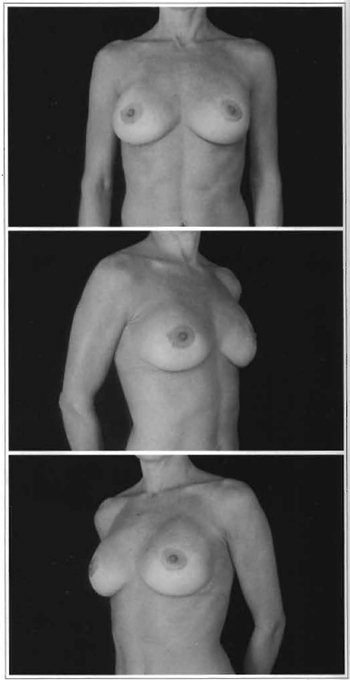
Figs. 4d-4f -Patient in picture 4: at 3-month postoperative period. Using 180 cc prosthesis on R breast, with reduction of periareolar skin. On L breast, 235 cc prosthesis, local flap for upper quadrant with reduction of periareolar skin (resection greater than 1/5 of breast volume -Group III).
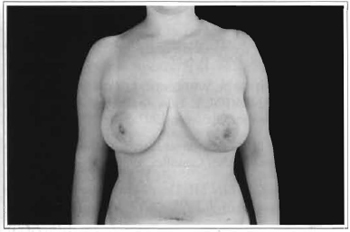
Fig. 5a -Preoperative assessment: 43 year-old, with invasive ductal carcinoma on L breast.

Fig.5b - 6-month postoperative period. Sectorectomy with skin resection on upper quadrant and use of lower pedicle flap as an island on the upper quadrant of left side breast. Note mimitization with adjacent skin. Reduction of about 280 g of L breast combined with sectorectomy of R breast to attain symmetry, providing similar volume for both breasts (Group IV -special cases).
Histological studies showed that 92% of the patients presented invasive ductal carcinoma, 5% had invasive lobular carcinoma, and 3% of the tumors were in situ carcinomas.
All patients agreed, after clarification, to undergo both procedures in a single surgical event, and were informed that clinical follow-up would be necessary.
All patients underwent radiation therapy as an adjuvant treatment (4). Those with invasive tumors also underwent sentinel lymph node dissection or axillary drainage, and received chemotherapy.
RESULTS
None of the patients experienced serious complications during the follow-up period. One patient in Group I had a seroma that drained spontaneously, which did not mea the result. Average hospital stay was 24 hours. None of the four groups presented clinical differences in their follow-up. Group IV patients, the so-called special cases, were more challenging in terms of technical planning, as the treatment procedure was decided only during the surgical event because histological diagnoses were not clear enough. In these cases, flaps, not routinely used were employed.
The aesthetic result was regarded as satisfactory, considering the need to preserve mammarian symmetry for all patients and the absence of noticeable scar defects. Subjective evaluations were provided by patients in the questionnaires used in the postoperative follow-up period The questionnaires showed that 80% of the patients felt they had had their identities as women preserved; 70% reported reduction of psychological distress, characterized by greater survival expectations and less anxiety. Of the patients treated, 70% reported psychosocial re-adaptation; that is, they resumed their regular activities.
DISCUSSION
Systematization of the treatment for breast cancer, as presented in this study, differs from the traditional approach in which tumor resection and reconstruction take place in two distinct phases. The present study suggests that mastologists and plastic surgeons should work together to perform both oncology and aesthetic treatments in a single procedure. The reduction of the healthy breast, when carried out simultaneously with the resection of the tumorous tissue, permits better sizing of the final mammarian volume, facilitating symmetry. Moreover, the possibility of identifying malignant cells in the breast considered healthy significantly improved prognosis for patients.
This study with 58 patients showed that the aesthetic results were not affected by the type of tumor, or by the amount of tissue resected by the mastologist. The combination of oncologic and aesthetic treatments in a single surgical procedure should lead to reduce costs, decrease anesthetic risks, and lower patient anxiety (12,13).
The method described herein proved effective in improving the quality of life of the breast cancer groups treated by minimizing adverse psychosocial effects, reducing the feeling of mutilation and controlling the panic often present in patients with malignant diseases.
CONCLUSION
From an aesthetic point of view, the joint work of mastologists and plastic surgeons proved beneficial, in all 58 cases studied. The short clinical follow-up period was not long enough to determine its therapeutic effects for tumors. Aesthetic advantages were reported by all patients, and most of them felt comfortable with the results. The combination of two procedures in a single surgical procedure provides considerable savings, in addition to cutting surgical trauma in half.
REFERENCES
1. ARMOSTRONG K, EISTN A, WEBER B. Assessing the risk of breast cancer. N. Engl. J. Med. 2000; 342:564-70.
2. AGOSTINI A. Ocorrência de neoplasia de mama no Instituto de Patologia de Passo Fundo, R.G.S., nos Ultimos três anos. Comunicação pessoal, 2001.
3. DURTEIN H, WINER W. Primary care for survivors of breast cancer. N. Engl. J. Med. 2000; 343: 1086-92.
4. MENK C, et al. Rotinas em Mastologia. Porto Alegre: Artes Medicas, 2000. pp 124-6.
5. DEITOS F, et al. Estresse, cancel; imunidade. Santa Maria: Ed. Kaza Doze, 1997.
6. WALLSH FMC, GOLDRICK M. Morte na familia, sobrevivendo as perdas. Porto Alegre: Ed. Artes Medicas, 1998.
7. GOES JCS. Mastectomia com Reconstrução Imediata. Rev. Soc. Cir. Plást. Estit. Reconstr. 1995;10:44-45.
8. GOMES ATC. Mastologia Dinamica. Madrid: Dias Santos, 1995. p. 609.
9. SAMUEL A, WELLS JR, LECOY V, DOROTHY A, ANDRIOL E. Atlas de Cirurgia da Mama. Rio de Janeiro: Revimer, 1997. pp. 6774.
10. RIBEIRO L. Cirurgia Plástica de Mama. Rio de Janeiro: Medica Cientifica, 1989. pp. 247-63.
11. SILVASTEIN MJ. Ductal carcinoma in situ of the breast. B. M.J. 1998; 317:734-9.
12. DOWDEN RV; HORTON CE, ROSATO FE, McGRAW JB. Reconstruction of the breast after mastectomy for cancer. Surg. Gynecol. Obstet. 1979; 149:109.
13. BOSTWICKJ, VASCONEZLO,JURKIZWICZ MJ. Breast reconstruction after radical mastectomy. Plast. Reconstr. Surg. 1976; 61 :682-4.
I - Senior member of the Brazilian Society of Plastic Surgery. Head of the plastic surgery service of Hospital Divina Providência, Porro Alegre, Brazil.
II - Specialist member of the Brazilian Society of Plastic Surgery.
III - Professor of Gynecology and Obstetrics at Universidade Federal do Rio Grande do Sul.
Address for correspondence:
Miriam Luisa Pedron, MD
R. Dr. Barbosa Gonçalves, 660
91330-320 -Porro Alegre -RS Brazil
Fone: (55 51) 3328-7933
e-mail: mlpedron@terra.com.br


 Read in Portuguese
Read in Portuguese
 Read in English
Read in English
 PDF PT
PDF PT
 Print
Print
 Send this article by email
Send this article by email
 How to Cite
How to Cite
 Mendeley
Mendeley
 Pocket
Pocket
 Twitter
Twitter